#Mainframe Modernization
Explore tagged Tumblr posts
Text
Your Trusted Partner in Mainframe Modernization: Vrnexgen
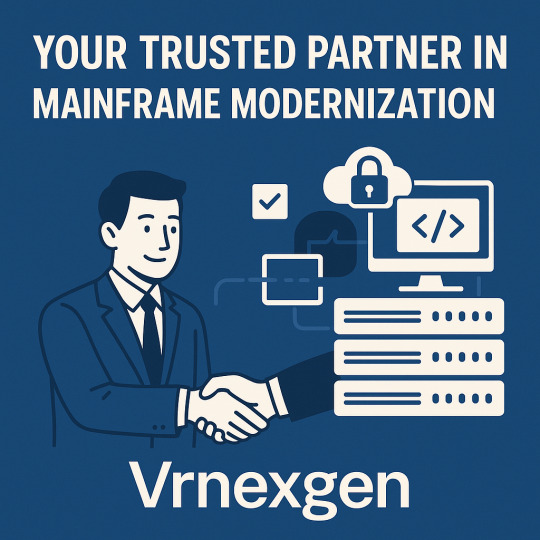
Vrnexgen is your trusted partner in mainframe modernization, offering seamless migration, integration, and transformation of legacy systems. With deep expertise, innovative tools, and a customer-first approach, we ensure a secure, scalable, and future-ready digital enterprise journey.
0 notes
Text
Modernizing Mainframes: Unleashing the Power of Digital Cloud Services
Introduction
In the era of digital transformation, where agility and scalability are paramount, mainframe systems, although venerable, can become significant roadblocks for organizations seeking to innovate and stay competitive. Modernizing mainframes through the adoption of digital cloud services has emerged as a strategic imperative. In this comprehensive guide, we'll delve into the world of mainframe modernization, exploring its significance, challenges, benefits, and best practices.
The Significance of Mainframe Modernization
Mainframe systems have been the backbone of many organizations for decades, providing stability and reliability. However, these legacy systems come with inherent limitations, such as high maintenance costs, rigidity, and difficulty in integrating with modern technologies. Mainframe modernization is the process of transitioning from these monolithic systems to agile, cloud-based solutions, and its significance lies in the transformative potential it offers:
Agility and Scalability: Cloud-based systems provide the agility and scalability required to adapt to rapidly changing business environments and accommodate growth seamlessly.
Cost Optimization: Modernizing mainframes can lead to substantial cost savings by reducing the need for expensive hardware and lowering maintenance costs.
Enhanced Performance: Cloud services are designed for high performance, offering faster data processing and reducing downtime, resulting in improved operational efficiency.
Flexibility: Cloud environments enable organizations to adopt a flexible, pay-as-you-go approach to resource allocation, eliminating the need for costly upfront investments.
Innovation: Mainframe modernization opens the door to harnessing advanced technologies such as artificial intelligence (AI), machine learning (ML), and the Internet of Things (IoT) to drive innovation.
Global Reach: Cloud services provide global accessibility, allowing organizations to serve a broader customer base without the need for physical data centers in multiple locations.
Benefits of Mainframe Modernization
The benefits of modernizing mainframes through digital cloud services are multifaceted and can drive transformational change within an organization. Let's explore these advantages in detail:
Improved Efficiency: Modernized systems can automate manual processes, streamline operations, and reduce the need for manual interventions, resulting in increased efficiency.
Cost Reduction: Cloud services often lead to cost savings by eliminating the need for substantial capital investments in hardware and reducing ongoing operational expenses.
Scalability: Cloud environments provide the ability to scale resources up or down based on demand, ensuring optimal performance and cost-efficiency.
Enhanced Security: Leading cloud providers invest heavily in security measures, offering robust protection against cyber threats and vulnerabilities.
Business Continuity: Cloud-based disaster recovery and backup solutions ensure data integrity and availability even in the face of unforeseen events.
Agility and Innovation: Modernized systems can quickly adopt and integrate new technologies, fostering innovation and adaptability.
Challenges in Mainframe Modernization
While the benefits of mainframe modernization are compelling, organizations must be prepared to navigate the challenges that come with this transformation:
Legacy Integration: Migrating away from mainframes often involves complex integration with existing systems, which can be time-consuming and challenging.
Data Migration: Transferring large volumes of data from mainframes to the cloud can be cumbersome and requires meticulous planning to ensure data integrity and security.
Security Concerns: While cloud providers offer robust security measures, organizations must also take responsibility for securing their data and applications in the cloud.
Change Management: Employees may resist changes to their familiar workflows and systems. Effective change management strategies are crucial to a successful migration.
Vendor Lock-In: Choosing the right cloud provider is essential, as vendor lock-in can limit flexibility and increase costs in the long run.
Best Practices for Mainframe Modernization
To overcome these challenges and ensure a successful mainframe modernization, organizations should adhere to best practices:
Comprehensive Assessment: Begin with a thorough assessment of your current mainframe environment to understand its intricacies and dependencies.
Clear Goals and Prioritization: Define clear modernization goals and prioritize workloads based on business value, complexity, and readiness for migration.
Data Management Strategy: Develop a robust data migration strategy that includes data cleansing, validation, and migration testing to minimize risks and maintain data integrity.
Security First: Implement stringent security measures, including encryption, access controls, and regular compliance audits, to protect data in transit and at rest.
Change Management: Invest in change management programs to prepare employees for the transition and ensure they can effectively utilize modernized systems.
Cost Optimization: Continuously monitor and optimize cloud costs to prevent overspending and ensure that resources are used efficiently.
Vendor Evaluation: Carefully evaluate cloud service providers based on factors like performance, security, pricing, and vendor lock-in before making a decision.
Conclusion
Mainframe modernization through the adoption of digital cloud services is a strategic imperative for organizations aiming to thrive in the digital age. By breaking free from the constraints of legacy mainframe systems and embracing the agility and scalability offered by the cloud, businesses can position themselves for long-term success and continued growth.
While challenges exist, a well-defined strategy, commitment to security, and adherence to best practices can pave the way for a successful mainframe modernization. In an era of rapid technological advancement, embracing the cloud isn't just an upgrade—it's a strategic transformation that can redefine how organizations operate, innovate, and remain competitive in a rapidly evolving digital landscape.
0 notes
Text
Still running critical systems on COBOL? Here’s how to modernize without risking everything. Safe, smart, and step-by-step.
0 notes
Video
EAI 640 Digital Computing System, 1966 by Colorcubic™ Via Flickr: via colorcubic.com/2010/10/27/eai-640-digital-computing-system/
1 note
·
View note
Text
How Mainframe Security Can Be Enhanced Through Modernization
Security is one of the core strengths of mainframe systems, but modernizing legacy infrastructure introduces new security considerations. At VRGZLABS, we implement mainframe security enhancements as part of our comprehensive modernization strategies. By adopting advanced encryption methods, integrating multi-factor authentication (MFA), and securing APIs, we help enterprises protect their legacy systems in an increasingly complex threat landscape. Discover how modernization can enhance your mainframe’s security without sacrificing the robustness and reliability of your system.
1 note
·
View note
Text
Mainframe Performance Optimization Techniques
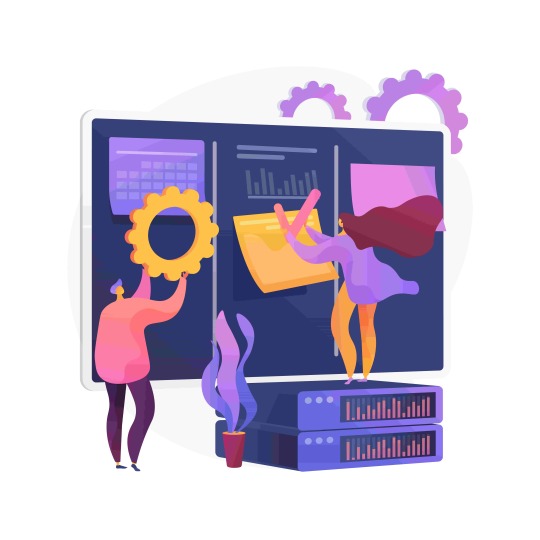
Mainframe performance optimization is crucial for organizations relying on these powerful computing systems to ensure efficient and cost-effective operations. Here are some key techniques and best practices for optimizing mainframe performance:
1. Capacity Planning: Understand your workload and resource requirements. Accurately estimate future needs to allocate resources efficiently. This involves monitoring trends, historical data analysis, and growth projections.
2. Workload Management: Prioritize and allocate resources based on business needs. Ensure that critical workloads get the necessary resources while lower-priority tasks are appropriately throttled.
3. Batch Window Optimization: Efficiently schedule batch jobs to maximize system utilization. Minimize overlap and contention for resources during batch processing windows.
4. Storage Optimization: Regularly review and manage storage capacity. Employ data compression, data archiving, and data purging strategies to free up storage resources.
5. Indexing and Data Access: Optimize database performance by creating and maintaining efficient indexes. Tune SQL queries to minimize resource consumption and improve response times.
6. CICS and IMS Tuning: Tune your transaction processing environments like CICS (Customer Information Control System) and IMS (Information Management System) to minimize response times and resource utilization.
7. I/O Optimization: Reduce I/O bottlenecks by optimizing the placement of data sets and using techniques like buffering and caching.
8. Memory Management: Efficiently manage mainframe memory to minimize paging and maximize available RAM for critical tasks. Monitor memory usage and adjust configurations as needed.
9. CPU Optimization: Monitor CPU usage and identify resource-intensive tasks. Optimize code, reduce unnecessary CPU cycles, and consider parallel processing for CPU-bound tasks.
10. Subsystem Tuning: Mainframes often consist of various subsystems like DB2, z/OS, and MQ. Each subsystem should be tuned for optimal performance based on specific workload requirements.
11. Parallel Processing: Leverage parallel processing capabilities to distribute workloads across multiple processors or regions to improve processing speed and reduce contention.
12. Batch Processing Optimization: Optimize batch job execution by minimizing I/O, improving sorting algorithms, and parallelizing batch processing tasks.
13. Compression Techniques: Use compression algorithms to reduce the size of data stored on disk, which can lead to significant storage and I/O savings.
14. Monitoring and Performance Analysis Tools: Employ specialized tools and monitoring software to continuously assess system performance, detect bottlenecks, and troubleshoot issues in real-time.
15. Tuning Documentation: Maintain comprehensive documentation of configuration settings, tuning parameters, and performance benchmarks. This documentation helps in identifying and resolving performance issues effectively.
16. Regular Maintenance: Keep the mainframe software and hardware up-to-date with the latest patches and updates provided by the vendor. Regular maintenance can resolve known performance issues.
17. Training and Skill Development: Invest in training for your mainframe staff to ensure they have the skills and knowledge to effectively manage and optimize the system.
18. Cost Management: Consider the cost implications of performance tuning. Sometimes, adding more resources may be more cost-effective than extensive tuning efforts.
19. Capacity Testing: Conduct load and stress testing to evaluate how the mainframe handles peak workloads. Identify potential bottlenecks and make necessary adjustments.
20. Security Considerations: Ensure that performance optimizations do not compromise mainframe security. Balance performance improvements with security requirements.
Mainframe performance optimization is an ongoing process that requires constant monitoring and adjustment to meet evolving business needs. By implementing these techniques and best practices, organizations can maximize the value of their mainframe investments and ensure smooth and efficient operations.
#Mainframe Application#data management#Database management systems#Modern mainframe applications#cloud services
0 notes
Text
Digital Transformation Services
Your Switch to a Digital Future – Digital Transformation Consulting Services
Being a leading name amongst Digital Transformation Company and Service providers, Enterprise Mobility has been handholding enterprises on their Digital Transformation journeys for two decades now
#enterprise mobility#digital transformation#enterprise mobility management#enterprise mobility service#Mobility Strategy and Consulting#Custom Enterprise Mobile App#digital transformation service#digital transformation consulting#digital transformation company#Digital Transformation Consultation#Legacy Modernization#Legacy Modernization Services#Legacy App Modernization#Legacy Mainframe#Legacy Application Modernization#Legacy Application Maintenance#Legacy Application Management#App Modernization Services#Enterprise Application Modernization#IoT Development
1 note
·
View note
Text
♯ [!!!] » Acc░ss ▓rant▒d~:
She listened. Waited. Expecting a reaction more akin to a panic or concern that usually occurred during these little encounters she'd had in the past when the tech stack of an unfortunate organization hit her radar and something popped.
CTOs of financial firms offering hush money personally to preserve their appearance in the industry. Information Tech Officers from logistics corps screaming to have their data returned before morning — hemorrhaging millions every hour trucks, ships, and planes sat idle. InfoSec VPs from nearly every vertical, terrified of being tomorrow’s headline as the next scapegoat fired to make it seem like the victim company was ‘doing something.’
All of them posturing to some degree to preserve themselves over actually giving a shit about investing in their architecture. She used to take it more seriously. Used to create ominous video messages with glitched out text like those Anonymous kids. Then that turned... boring. Now, it was just sport. A l a z y tap on the glass. A warning to the capitalists that thought they were untouchable while doing the bare minimum to save a dime for the sake of stakeholder ‘profitability’.
But this one…
No panic.
Barely even an undercurrent of concern.
Irritation? Sure. But that was it. Didn't even make a demand. She was almost offended.
Who the hell was she talking to?
There was little chance this was some blue team security tech or incident responder. Too cool. Too calm. None of that underlying twitchy fear of losing their job. Not legal either — lawyers opened with threats, not admissions. This one… sounded like a man nursing a migraine while rotating knives between his fingers and reading off a script handed to him by PR.
And there was an air of authority behind his bullshit press statement that indicated someone with a higher pay grade. And suits only pick up the phone when something important is at risk.
Which begged the question -- what had she tripped over?
With a few clicks, Sen7inel opened up the recon files from her quick peruse she took through the network earlier for another review on screen, internally cursing herself for being too lazy to run a more intensive scan. The subnet had looked like a dead zone — endpoints barely whispering with heartbeat pings and encrypted packets. No standard traffic patterns she’d expect from a healthcare environment -- or one remotely similar. No EHR syncs. No timed burst batches of med data.
No — this appeared quieter. Cleaner. Sterile.
'Interesting.'
Her head tilted slightly. “Oh, come now, Mr. TRICELL.” It oozed from her mouth with saccharine mockery, a fiendish curl of a grin creeping upward. “You, me, and the dark corners of the internet all know pharma corps know how to move product around -- regardless of your system status. I'd bet good money that there's a number of shipments that are never logged that make it to their final destination just fine."
Alright — maybe she was leaning into the rumors from the cesspool of conspiracy theorists that hid out in the deepest trenches of the net. Maybe she read some. Maybe she made some up herself. She definitely made some up herself. But it was hard not to after the accusations that had been publicly and privately hurled at Umbrella during its downfall.
And when would she get another opportunity to throw such accusations around to see if she could make a pharma exec choke?
She leaned forward now, elbows on the desk, chin resting on folded hands. Her tone dropped — not louder, but closer. "Besides,” she murmured, "I didn't see any lifesaving going on behind that subnet." A beat, then more pointed, "which means that's not what you're actually mad about… huh?"
A lone Linksys E4200's logs are empty. They should be full of useless telemetry to seed 𝚕𝚌𝚐_𝚛𝚊𝚗𝚍().
[𝚃𝚃𝚈 𝚜𝚝𝚊𝚛𝚝𝚎𝚍, 𝙿𝙸𝙳 𝟾𝟸𝟶𝟹.]
Like any sitting duck, it has been inevitably shot, and the digital gore of one dusty, obscure backup server connected through LAN with file transfers has enabled a cascading, unprecedented breach to occur in a facility that he doubts this attacker is aware of the true significance of.
Why did it always fall to him - or Excella - to speak to whatever jester of the hour jingled by?
This duty — like tucking a tail between the legs — bruises his ego. And though he can play the part, it does not necessitate he desire to.
Naturally, it falls to him to answer. Wesker is the only one of two options that retains any modicum of IT knowledge, even if it's tailored to the long-defunct Z-series. He reclines with a sigh in his chair, a printed incident report — the only thing he trusts to be true in this room — in one hand, an unplugged Ethernet cord being twirled idly in the digits of his other.
Bone conduction carries the attacker's voice. The first string to pull will be guilt — "You do realize you're currently disrupting the availability of life-saving pharmaceuticals to hospitals, yes?" It is delivered smoothly, but the wry hint isn't lost.
Keeping the attacker on longer will allow internal teams more time to mount a defense, which currently consists of isolating the router by pulling services offline one-by-one, going under like glittering lights - green, yellow, then red...
"They will be dealt with." There is something restrained in that.
...and it's less time for them — no, her — to grep valuable data that would provide the RSA keys to—
In bitter hindsight, Wesker had known it was a bad idea. He'd warned the engineers when they decided to trim operating cost by scaling back infrastructure, nixing the upper-level's physical firewall.
So, when it was child's play to break in to the E4200, he was unsurprised. After all...
No firmware updates for three years.
Front-facing...
Not connected to Snort.
No matter how much you slather on top of it, you were bound to be found if your foundation wobbled.
He scoffs at her tone - she sounds so unbothered, careless. What kind of hacker exposes their vocal biometrics so freely? When he next speaks, his voice is measured calm — "We take data breaches very seriously here at TRICELL." There's a crackling pause as he breathes in an audible sigh, waiting for demands impatiently. This insolence detracts from important work.
#progenitorensis#ic;#au; re#// it took me an embarrassingly long time to figure out how to trim posts -- my apologies for the delay#// tryin to convey she doesn't really know who shes talking to and only knows of the conspiracy theories surrounding umbrella not deets#// i am assuming this is before the events of re5 given your profile but lemme know if you wanna go more modern#// also i appreciate your specific references -- i have some snort swag in my office lmao#// also also -- yes umbrella totally used that era of 390x's omg i suspect they had mainframes way past when they should have#// i feel like umbrella was the corp that invested heavily in it's medical equipment -- but probably did shit for the IT backbone lol#// something something “sunk costs”
5 notes
·
View notes
Text
The so-called Department of Government Efficiency (DOGE) is starting to put together a team to migrate the Social Security Administration’s (SSA) computer systems entirely off one of its oldest programming languages in a matter of months, potentially putting the integrity of the system—and the benefits on which tens of millions of Americans rely—at risk.
The project is being organized by Elon Musk lieutenant Steve Davis, multiple sources who were not given permission to talk to the media tell WIRED, and aims to migrate all SSA systems off COBOL, one of the first common business-oriented programming languages, and onto a more modern replacement like Java within a scheduled tight timeframe of a few months.
Under any circumstances, a migration of this size and scale would be a massive undertaking, experts tell WIRED, but the expedited deadline runs the risk of obstructing payments to the more than 65 million people in the US currently receiving Social Security benefits.
“Of course, one of the big risks is not underpayment or overpayment per se; [it’s also] not paying someone at all and not knowing about it. The invisible errors and omissions,” an SSA technologist tells WIRED.
The Social Security Administration did not immediately reply to WIRED’s request for comment.
SSA has been under increasing scrutiny from president Donald Trump’s administration. In February, Musk took aim at SSA, falsely claiming that the agency was rife with fraud. Specifically, Musk pointed to data he allegedly pulled from the system that showed 150-year-olds in the US were receiving benefits, something that isn’t actually happening. Over the last few weeks, following significant cuts to the agency by DOGE, SSA has suffered frequent website crashes and long wait times over the phone, The Washington Post reported this week.
This proposed migration isn’t the first time SSA has tried to move away from COBOL: In 2017, SSA announced a plan to receive hundreds of millions in funding to replace its core systems. The agency predicted that it would take around five years to modernize these systems. Because of the coronavirus pandemic in 2020, the agency pivoted away from this work to focus on more public-facing projects.
Like many legacy government IT systems, SSA systems contain code written in COBOL, a programming language created in part in the 1950s by computing pioneer Grace Hopper. The Defense Department essentially pressured private industry to use COBOL soon after its creation, spurring widespread adoption and making it one of the most widely used languages for mainframes, or computer systems that process and store large amounts of data quickly, by the 1970s. (At least one DOD-related website praising Hopper's accomplishments is no longer active, likely following the Trump administration’s DEI purge of military acknowledgements.)
As recently as 2016, SSA’s infrastructure contained more than 60 million lines of code written in COBOL, with millions more written in other legacy coding languages, the agency’s Office of the Inspector General found. In fact, SSA’s core programmatic systems and architecture haven’t been “substantially” updated since the 1980s when the agency developed its own database system called MADAM, or the Master Data Access Method, which was written in COBOL and Assembler, according to SSA’s 2017 modernization plan.
SSA’s core “logic” is also written largely in COBOL. This is the code that issues social security numbers, manages payments, and even calculates the total amount beneficiaries should receive for different services, a former senior SSA technologist who worked in the office of the chief information officer says. Even minor changes could result in cascading failures across programs.
“If you weren't worried about a whole bunch of people not getting benefits or getting the wrong benefits, or getting the wrong entitlements, or having to wait ages, then sure go ahead,” says Dan Hon, principal of Very Little Gravitas, a technology strategy consultancy that helps government modernize services, about completing such a migration in a short timeframe.
It’s unclear when exactly the code migration would start. A recent document circulated amongst SSA staff laying out the agency’s priorities through May does not mention it, instead naming other priorities like terminating “non-essential contracts” and adopting artificial intelligence to “augment” administrative and technical writing.
Earlier this month, WIRED reported that at least 10 DOGE operatives were currently working within SSA, including a number of young and inexperienced engineers like Luke Farritor and Ethan Shaotran. At the time, sources told WIRED that the DOGE operatives would focus on how people identify themselves to access their benefits online.
Sources within SSA expect the project to begin in earnest once DOGE identifies and marks remaining beneficiaries as deceased and connecting disparate agency databases. In a Thursday morning court filing, an affidavit from SSA acting administrator Leland Dudek said that at least two DOGE operatives are currently working on a project formally called the “Are You Alive Project,” targeting what these operatives believe to be improper payments and fraud within the agency’s system by calling individual beneficiaries. The agency is currently battling for sweeping access to SSA’s systems in court to finish this work. (Again, 150-year-olds are not collecting social security benefits. That specific age was likely a quirk of COBOL. It doesn’t include a date type, so dates are often coded to a specific reference point—May 20, 1875, the date of an international standards-setting conference held in Paris, known as the Convention du Mètre.)
In order to migrate all COBOL code into a more modern language within a few months, DOGE would likely need to employ some form of generative artificial intelligence to help translate the millions of lines of code, sources tell WIRED. “DOGE thinks if they can say they got rid of all the COBOL in months, then their way is the right way, and we all just suck for not breaking shit,” says the SSA technologist.
DOGE would also need to develop tests to ensure the new system’s outputs match the previous one. It would be difficult to resolve all of the possible edge cases over the course of several years, let alone months, adds the SSA technologist.
“This is an environment that is held together with bail wire and duct tape,” the former senior SSA technologist working in the office of the chief information officer tells WIRED. “The leaders need to understand that they’re dealing with a house of cards or Jenga. If they start pulling pieces out, which they’ve already stated they’re doing, things can break.”
260 notes
·
View notes
Text
Saw a post where someone wasn't sure if Tim being good at computers was a fanon thing or not and friend I am happy to inform you that he's been a computer/tech guy from some of his earliest appearances in the comics.
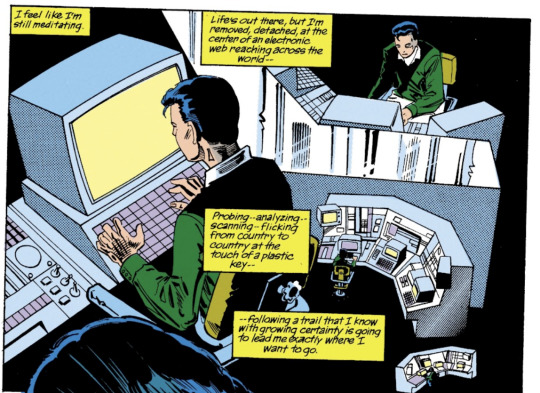
Detective Comics (Vol. 1) #620 (Rite of Passage part 4) - immersed in the ~web~
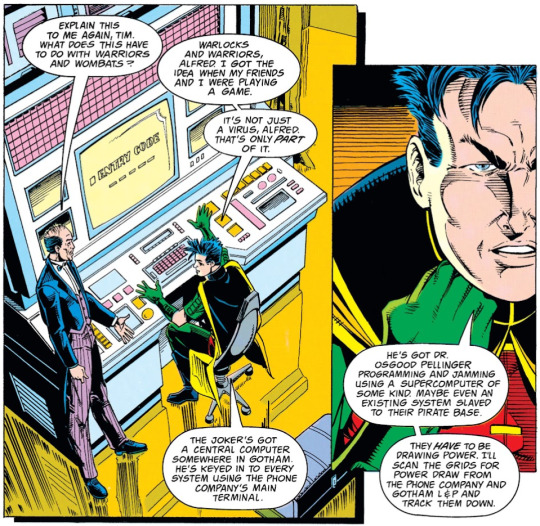

Robin II: The Joker's Wild #3 - tabletop roleplaying games and spending hours in the basement on the computer - not beating the geek allegations on these fronts, Timmy

Detective Comics (Vol. 1) #676 - Dick was more into traditional detective work and tended to outsource the computer stuff in these days
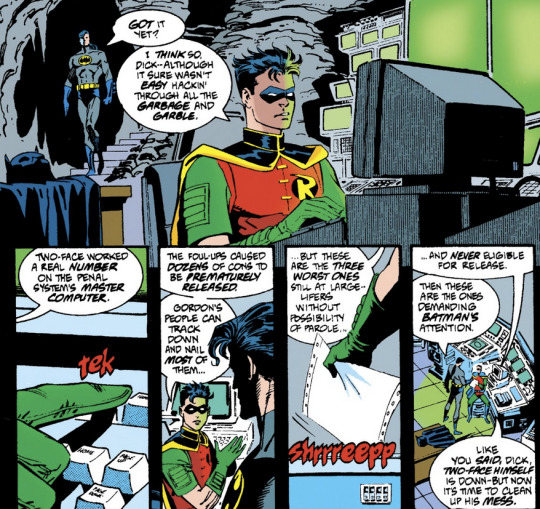
Batman (Vol. 1) #514 (Prodigal part 10) - hackin' through all the garbage and garble

Robin (1993) #33 - Robin sneaking in and connecting Oracle with the baddies' mainframe so she can do her thing and steal all their data >:)

Nightwing (1996) #6 - "no you're really talented and well suited to be Robin." "no, you." "no, YOU!"
Tim is definitely not as good as Babs/Oracle, but he's certainly her back-up for computer work in the 90's batfam. They're tech buddies and Robin!Tim is her little assistant sometimes, it's super cute:

Birds of Prey (1999) #19 - happy to play with big sister's fancy high-powered toys

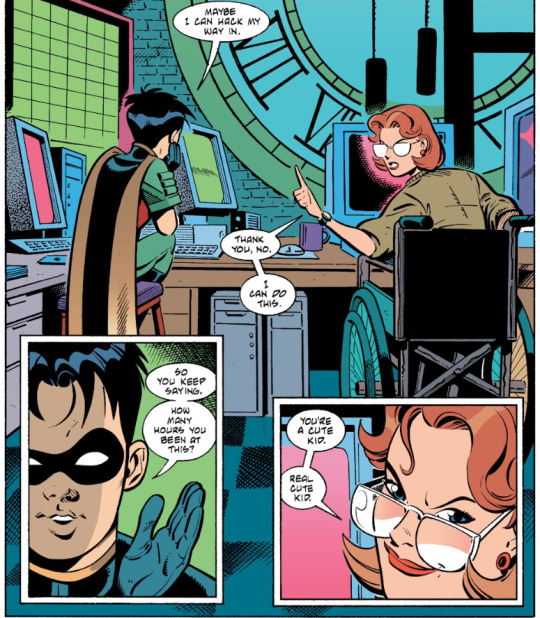
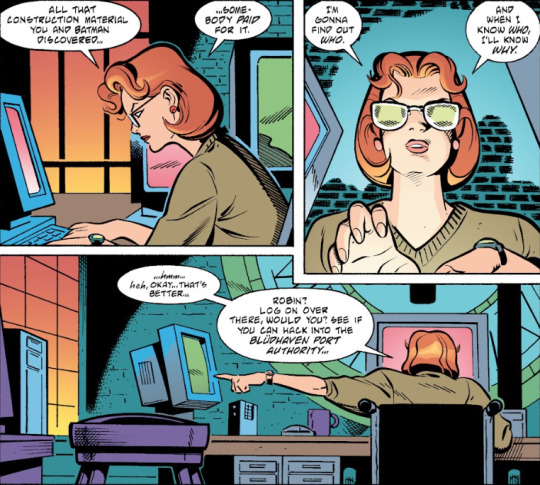
Legends of the Dark Knight (1989) #125 - real cute kid
And Dick will hand off computer jobs to his little brother when he doesn't want to bother Babs 😂 (that outsourcing I mentioned):


Nightwing (1996) #68 - examine them pixel by pixel, eh? welp, sounds like a job only you can do, Timbo, you got this buddy, byyyyeeeee
And then when he'd grown up and been doing this for years, he leveled up accordingly, and did stuff like use his access to the League of Assassins computers to overload the generators in every base he could find, etc. etc.
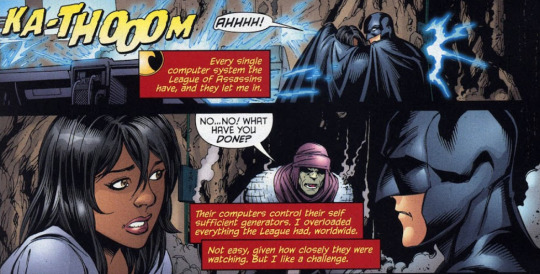
Red Robin (2009) #8 - yeah that was pretty dumb of you Ra's :)
So yeah, it was a bit of a specialty of Tim's, in large part because he was introduced just at the turn into the 90's, when personal computers were really starting to take off and become widespread. (Robins gotta be cutting edge and all)
Of course, by no means does it follow that the other Bats suck at computers (there is no 'smart one' they are all incredibly smart and capable). This is especially true as reboots and the sliding timescale of comics have moved the DC characters into modern times, where computers run the world and everyone grows up with one in their pocket. The baseline familiarity and expertise that everyone can be expected to have is just much, much higher these days.
It gets exaggerated in fanon as all character traits do, but computer guy Tim is definitely not something just made up out of whole cloth :)b
#not a fully extensive list by any means - just the stuff that I could find from my notes and general rummaging#Also: there are some fantastic additions to this in the comments so check out the notes!#Tim Drake#Robin#DC Comics#batfam#Dick Grayson#Nightwing#Barbara Gordon#Oracle#Alfred Pennyworth#Batman#Dick and Tim#Dick & Tim#Babs and Tim#DC Comics panels#fanon vs. canon#DC meta#meta#post tag#comic reading tag
773 notes
·
View notes
Text
VRNexGen: Your Trusted Partner in Mainframe Modernization
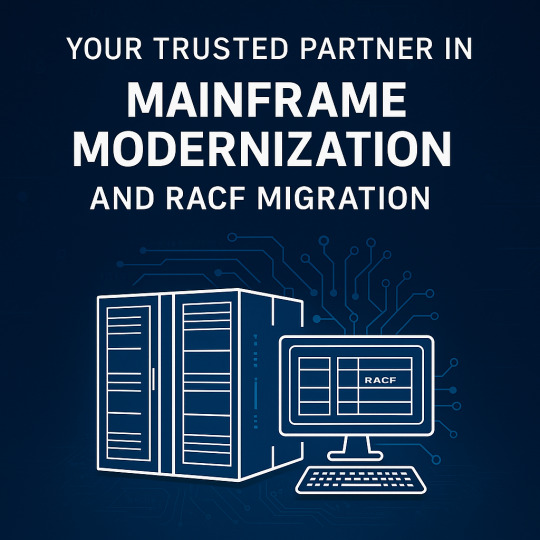
VRNexGen is a leading technology consulting firm specializing in mainframe modernization. With a deep understanding of legacy systems and a forward-thinking approach, we assist organizations in transforming their mainframe environments to meet the demands of today's digital landscape.
#mainframe modernization#Mainframe Infrastructure Upgrade#Legacy System Modernization#Mainframe Transformation Partner#Mainframe Modernization Services#VRNexGen
1 note
·
View note
Text
Disco Elysium has a lot of fascinating fictional technology but I have been rotating the radiocomputer in my mind for months now. From what I can gather, they operate in a way very similar to modern cloud computing. It doesn't seem like the mainframes we interact with have any processing capability. Instead, they use antennas to process "on air":
SOONA, THE PROGRAMMER - "Alright, well... All radiocomputers perform operations up on air, so in order to gain more processing power you need to invest in a *good antenna*."
The only information we get about what "on air" really means is from the same conversation with Soona:
YOU - "Wait, what's 'on air'?" SOONA, THE PROGRAMMER - "On the *front*. The unified front of radiowaves, licensed and controlled by Lintel in the East-Insulindic region." SOONA, THE PROGRAMMER - "It's all around us," she waves her hand, "that's what 'on air' means."
The nonspecific language used here really invokes cloud computing to me. I think there are two main possibilities for how this could work, one being much more likely than the other.
The more likely answer is that information is sent to and from the in-game equivalent of data centers, which would host massive computers with processing capabilities. I'm not sure what their processors would look like, but they'd almost certainly be analog (the lost Feld tape computers are most likely the in-game equivalent of early digital computers).
The significantly less likely (but more interesting) answer is that in-game radio waves are somehow capable of processing information on their own. I have no idea how this would work, and as far as I know there's no real-world analog. But it's clear the world of Disco Elysium has some crazy things happening with radio waves (see how they interact with the pale), so I'm not ruling it out entirely.
The filament memories are like hard drives, but my guess is they would function more similarly to an optical disc (CDs, DVDs), which use patterns in the disc to encode information that's read using lasers or light. The filaments glow inside the mainframe, so it's not a huge leap to assume they're read using light.
The amount of thought put into radiocomputers is so fascinating. As far as I can tell, their version of the internet has been wireless from the get-go, which makes perfect sense! Antennas and other wireless radio technologies would have to be pretty damn powerful to communicate across and force dimensions on the pale. And you have to assume huge amounts of government money has gone into funding their research and development for those purposes. The technology of radiocomputers is so tailored to the world of Disco Elysium, and it's been a lot of fun trying to untangle how exactly they would work.
#i would loooove to hear other people's thoughts on this!! i tried to find conversations abt it and didn't come up with much#also if anyone wants me to elaborate on the feld tape computer thing lmk... its a long post so i didn't want to go into more detail#but i do have Thoughts about it#cyan.txt#disco elysium#disco elysium meta#soona the programmer
624 notes
·
View notes
Text
Stuff in Thicker Than that I'm never sure how to describe:
The fashion. It's 2030, almost 2031 by the end of the story. What are they wearing? I dunno. I'm kinda scared to write anything particular because 2030 is so close that anything I write will be dated really fucking soon.
The vampire's hunger. One of the criticisms of Blood Moon which I thought was totally valid was that the howling was kinda reparative and sometimes annoying. I was trying to portray what it would be like for a werewolf, trying to act and be normal all while the moon was whispering hunthunthunthunthunt in their ear (except it's not really that word, it's more just that impulse, pushed straight into their brain). I want to do a better job with the vampires, describe what it's like to exist while always hungry. Sometimes I think I do okay, but sometimes I think it's just as repetitive and annoying. The werewolves want to clawclawclawclaw and bitebitebitebite and killkillkillkill but the vampires just want... more and more and more and more.
Nathan's tattoos. They're fuzzy and indistinct in my head, because I can't decide if they should be bold, fine, beautiful, crude, complex, smooth, zigzaggy, etc. Every time I imagine them, I imagine them a little differently. Because there's a spell, there needs to be some form of language involved, so there are Hanzi (Chinese characters) threaded into the lines, but other than that, the design is totally up in the air.
Gaius' accent. Like... he's from a time and a place lost to history. How am I meant to describe his accent other to say that it's weird and a little all over the place? Sometimes he sounds like a normal, modern kid. You bet he can say 'like and subscribe' in a perfect, chirpy, upbeat American accent. But then an odd mood will take him and he'll sound so... alien. I'm never sure how to describe that.
The vampire's lack of reaction. It's been so fun but also so weird trying to figure out how to portray the emotions of creatures who don't emote. The only natural physical reaction a vampire has is their fangs popping when they're hungry, angry, or scared, or horny. I'd already written characters that didn't react normally in Of Monsters and Mainframes (the computers obviously don't have hands to wring, eyes to widen, to lips to bite), but the vampires are different. They can do all of those things, but only falsely. Genuine emotion leaves them blank. I love that about them. I love how eerie and performative it makes them. But it's also sometimes such a tricky thing to write.
135 notes
·
View notes
Note
Just read the latest chapter and I must say I do believe everyone deserves a break, and by that I mean why not just let them relax like if they were all actors. Maybe have Abel be what he wants from the 4th wall ask so there isn't any tension, it's just a fun non-canon event to wind down.
BREATHER
A RACEWAY AU ONESHOT
WARNING: none
~~~
"CUT!! Good job everyone, that's a wrap for today." The Author closed her notes for episode 13 of The Amazing Digital Raceway TV series.
As the set crew turned on the overhead lights to start cleaning, Seth tossed his newly lit cigarette and coughed. "Ugh...how much longer am I going to have to pretend to like these things?"
Pomni unzipped her tracksuit to the waist, took off the top half and tied the sleeves around her waist. The tracksuits were hot under the stage lights, so she was much more comfortable in her black tank top underneath. "You know you don't actually have to smoke those, right? They'll edit it in post."
"I'm a method actor. I can't work with this unless it's actually lit."
"...then don't inhale. Really, this is a you problem."
"meh, meh, meh. Shut up." He grabbed her jester hat and shoved it down over her eyes.
"Reeeeal professional." Caine walked up, still covered in electrical burn makeup. "You staying in character or something?" He handed a bottle of water to Pomni.
"Like I said, method." Seth dug around in his pockets for items to give back to the prop department. As he searched, a phone rang in his pants pocket.
Pomni gaped. "You had a cellphone on you the whole time!? AND IT WAS ON!? You could have ruined the scene!"
Seth took out his modern flip phone, ignoring Pomni, and answered it with a smile. "Hey, baby. Yeah, just finished up." He started walking away, paying no mind to Pomni or Caine. "Have you heard back from the Author about your audition? Yeah, I told her if she needed me to have a love interest, I would prefer it be you."
Pomni rolled her eyes. "I can't believe that's guy's your brother."
Caine raised an eyebrow. "He's not."
"But he looks just like you."
"I know, but we never knew each other before the casting call. Wild coincidence." Caine finished his water. "I was wondering...after we finish up here, would you like to join me for drinks? I know this really nice pub."
Pomni smirked. "Now who's method acting?"
Caine chuckled, blushing under his makeup. "Nah...no acting. Just, I think... I don't know...I've felt some chemistry here. I'd be very interested in getting to know you outside of work."
Pomni smiled sincerely. "I'd like that."
~
Gummigoo grunted as the makeup assistant took out the bright blue contacts that covered his whole eye. "These bloody things are awful." There was some relief with the eye wash, but not as much as he'd like.
"Sorry you have to deal with that." Abel said as he glanced over the script draft for the next episode. "But it looks like you're going to be wearing them for a while. Uh, good news, you're getting a costume change at least. Says here you wear a black tracksuit. Don't know why the Author waited an entire episode for the wardrobe change. Seems like an afterthought. I would've changed the moment I reincarnated."
Gummigoo shrugged. "Maybe the Author is taking details like that slower. I mean, think about it. You've supposedly been stuck in the walls for 15 or so years and you jump into the mainframe head first. Did you expect to know how to do things from the inside right away? Your character has never done that before. He doesn't know how to be 'god'."
"eh....I guess you're right." Abel tucked the script under his arm and saw Ragatha walking by with Jax. "Oh hey, you two alright? That was some intense stunt work today."
"I'm fine, dear. Don't you worry. Jax, however is-" Ragatha was cut off by Jax hurling into the barf bag. "...not doing so good."
Jax groaned, "The world is spinning in the wrong direction."
"And you said you could do your own stunts." Ragatha patted Jax on the back. "I'm taking you to the on-site medic for some help. You need to sit down. See you later Abel, Gummigoo." She waved to her co-stars and escorted Jax away.
"Crikey, I'd hate to be him right now." Gummigoo shook his head.
"Yeah...so, anyway, I also wanted to ask: HOW have you been able to hide your Australian accent the entire time you're me? You sound so different." Abel wondered.
Gummigoo laughed. "Lots of practice and American movies."
~
Kinger was a little sore from today. The crashes were a bit more intense than originally intended. But, without complaint, he made his way to wardrobe to change, where he came across Loo. "Oh, hello, Loo. Did you have fun today?"
Loo pouted, "No...I didn't even have a line this episode. I feel like I've been on the story less and less. My character feels so...useless."
Kinger sat next to her. "We don't know what's coming next. I'm sure the Author will figure something out. She's one of the most passionate directors I've ever worked with, and I've been doing this for a long time."
Loo sniffed and wiped her face. "I think she should just kill off my character and let me go home. I'm not needed here."
"Hey," Kinger said gently, taking her hand. "Yes, you are. Every character is important, even the background ones. They flesh out the story and give the audience different perspectives on character struggles throughout the plot."
"What about Bubble? They left after episode 12, and I haven't seen them-"
"Bubble's on hiatus. They had to be written out for a bit. Nothing to do with how useful they are. Don't compare your performance to the others. The sooner you stop doing that, the better off you'll be in this industry."
"...okay..."
"You're young, beautiful, talented and hard working. You'll go far, I just know it." Kinger gave her hand a reassuring squeeze.
"Thanks." Loo wasn't fully convinced, but she was grateful Kinger was trying.
~
"What do you mean you haven't heard back!?" Gangle screeched angrily into her phone at her agent. "I am a Shakespearean trained actor! I have a repertoire longer than all these other actors combined!! Well, maybe not Kinger, BUT STILL!! How have you come up with nothing!? You have 48 hours to find me a new offer or you're FIRED!!"
Gangle almost threw her phone. She couldn't believe it. Years of training and child acting and this backwater TV show was all she had for work. She could do SO much better than this. She DESERVED better than this.
She dialed a new number with tears in her eyes. "...mom? The agent you got me is useless! I'm still stuck with the TV show! I-...yes, it's popular or whatever, BUT I'M NOT THE MAIN STAR! I auditioned for the lead role and I got side-charactered! It's not fair!!" Gangle whined and cried, pulling the bow out of her hair in frustration.
~
Zooble was about to leave for the day, but was flagged down by the Author. "Hey, what's up?"
"A lot, Zooble." The Author sighed. "I need to touch base with you about your role in the next episode. Have you seen makeup and wardrobe about-"
"Oh, yeah, I have. They got the latex molds done. My new look should be done by time you're ready to film my scenes."
"Excellent. Best news I've heard all week."
"You look like you could use a drink." Zooble half joked.
"I really could, but I can't. I have too many projects that require my attention. My producers for Unseen are breathing down my neck for the next script. Not to mention co-witing for the Time Capsule and Harlequin shows. Sometimes I have time for spinoff scripts. Those are fun." The Author runs her hand through her hair.
"Wow. Maybe you're taking on too many projects at once? Take a break. Have a drink."
"....maybe. Once I get-" The Author's phone rang. "Excuse me." She stepped away and answered. "Hello?"
A smooth male voice came though. "I read the script. The answer's yes."
The Author could dance in place. "That's wonderful! I'll have the other drafts sent your way. Thank you for calling me yourself. Your agent was rather uppity about letting me even offer the role to you."
The man chuckled lightly. "He's a card. No, I like this a lot. You can count me in. In fact, I'd very much like to discuss my role in person. Are you available tonight?"
The Author almost dropped her stuff. "I am now."
#the amazing digital raceway#tadc raceway au#raceway au#tadc#the amazing digital circus#tadc au#raceway seth#raceway abel#tadc caine#tadc pomni#showtime tadc#sneaky lore
57 notes
·
View notes
Text
Back in an era when computers were the size of a room and only government agencies and large companies could afford to have one, IBM was king of the mainframes. But they had a lineup of several incompatible computers, some intended for scientific uses (the IBM 7090/7094), others were for commercial uses (the IBM 7080 and IBM 7010). IBM wanted to have a single unified architecture so that software could be exchanged between them and customers could upgrade from cheaper, lower powered machines to more higher powered ones.
What came out of it was the IBM System/360 line of mainframes (referring to the concept of "360 degrees" making up a circle) that ended up being the dominant mainframe computer for decades to come, it got cloned by competitors, and its descendants are still being produced to this day.
The IBM System/360 had many features that since then became foundational for modern computing.
An entirely binary number system. While some computers (such as the IBM 7090) used a binary system, others operated exclusively in decimal mode, encoded using binary coded decimals using 4 bits for each digit (such as the IBM 7080 and IBM 7010). Others went a step further and were only capable of storing decimal digits 0 to 9 (like the IBM 7070).
To store textual information, each character was stored in 8 bits, establishing the dominance of 8 bit bytes. Previous systems would typically use 6 bits to store text, and would usually only enable a single case of letters. The IBM 7070 didn't provide access to bits and characters were stored in 2 decimal digits. It was also one of the first machines to support the then new ASCII standard, although notably it provided much better support for IBM's proprietary EBCDIC encodings which came to dominate mainframe computing.
Even though it was a 32-bit system, memory was byte addressed. Previous systems would access memory one word at a time (for the IBM 7090, this was 36 bits per word, for the IBM 7010, this was 10 digits plus a sign), or had variable length words and accessed them through their last digits (IBM 7080 and IBM 7010). The IBM System/360 however accessed 32-bit words as 4 bytes by their lowest address byte.
Two's complement arithmetic. Previous machines (even the binary IBM 7090) would encode numbers as sign/magnitude pairs, so for example -3 would be encoded identically to 3 except for the sign bit. Two's complement encoding, now the standard in modern computers, makes it much easier to handle signed arithmetic, by storing -3 as a large power of 2 minus 3.
69 notes
·
View notes
Text
Supercomputum / mainframum
Objectum attraction to supercomputers / mainframes. This applies to both old and new models, retro and modern.
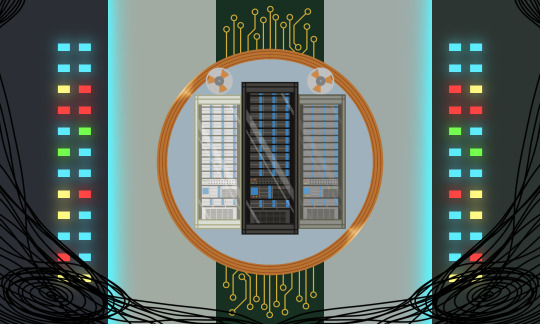
Was requested by anon
#objectum#flag coining#mainframum#supercomputum#mainframe objectum#supercomputer objectum#techum#mainframe#supercomputer#objectum coining#objectum flag#has id
17 notes
·
View notes
